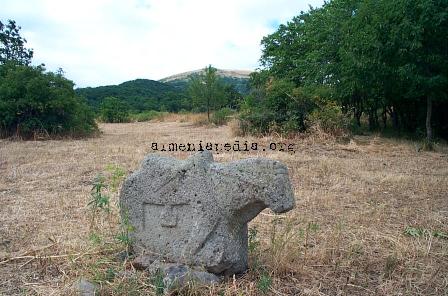Zoomorphic Tombstones
Horse- and ram-shaped tombstones
from the Caucasus and Anatolia
Among the ruins of the ancient city of Samshvilde (Georgian: სამშვილდე — "three bows") south-west from Tbilisi stand two equestrian funerary steles carved from single blocks of stone.
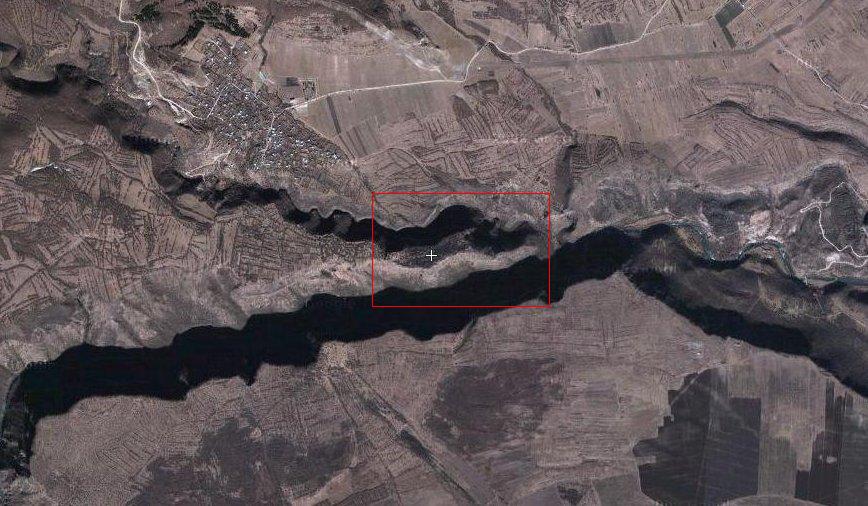
Samshvilde is—or, rather, was—situated atop a hill carved out of the surrounding plateau by two rivers, on a flat, progressively narrowing area approximately 1 km. long by 2-300 m. wide, the tip of the site dropping a sheer 150 m. down to where the two rivers converge. The site thus has excellent, steep natural defences, and was without doubt occupied for a very long period. Visible to this day are the ruins of an impressive castle astride the city wall (which sealed off the city from the widening hilltop area), a paved street running down the middle, wide enough for a car, the ruins of several large houses, walled fields, and a number of large basins, probably destined to collect rainwater. There are also the ruins of a large church, which in all likelihood dates back to the XIIth-XIIIth centuries. But the most interesting remains of human occupation of this site are without doubt the stone horses!
The larger of the two (approximately 150 cm. long and 80 cm. high) clearly commemorates the death of an important man, as its decoration is lavish and detailed. It was (perhaps "re-") erected in a clearing next to a small church, where it stands to this day, surrounded by the tables and benches placed there for the revellers who attend religious feasts in the church.
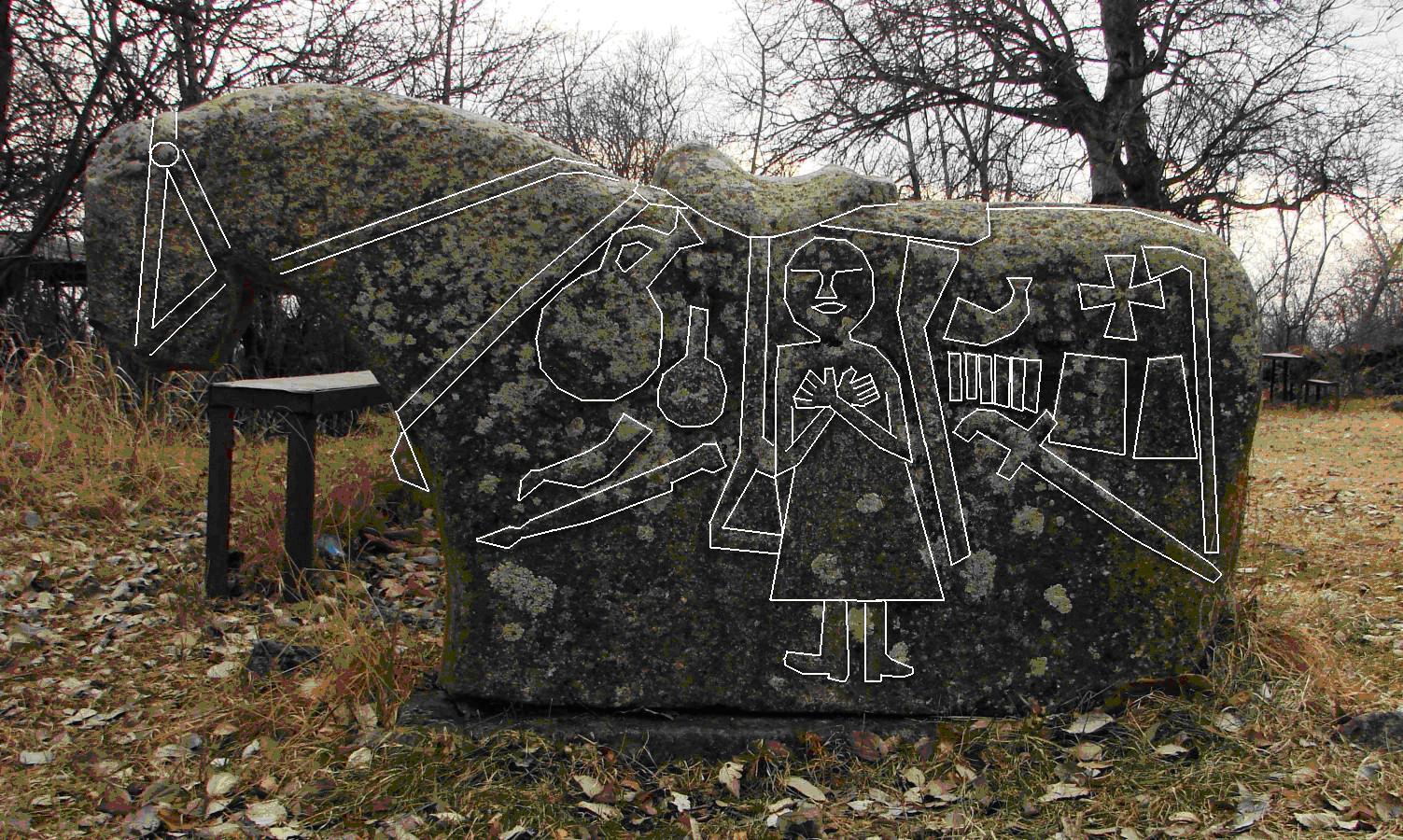
On the horse's left flank are carved the figure of a man with his arms crossed on his chest, hands open—probably represented as being in prayer or lying at rest (i.e. following burial)—and all the possessions this clearly important and wealthy person would have needed in the afterlife: His rifle with cartridges and a horn containing gunpowder; a dagger, a sword, and an axe; various drinking vessels such as a jug (most likely for wine), a smaller vessel, and a drinking-horn. There is also a small, Maltese-like cross just below the horse's rump. The horse itself is fully equipped, with a bridle with a bit, and an apparently padded saddle with stirrups placed atop a saddlecloth, the latter being held in place by a strap leading over the horse's rump to its tail and by another strap which encircles the horse's breast (where the strap seems to bear a semi-spherical decoration.)
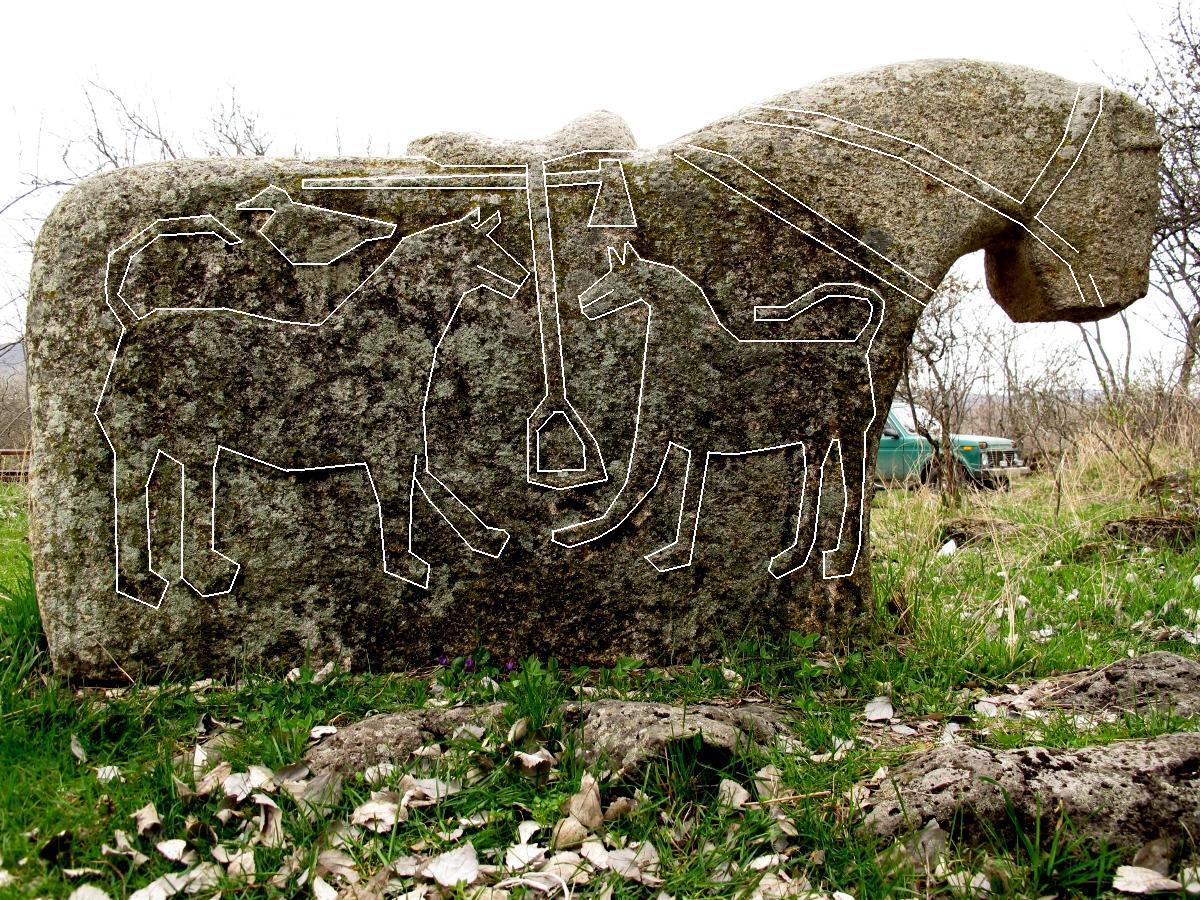
On the horse's right flank are two hunting dogs, holding their forepaws up towards each other - as if in greeting or submission - and a bird, which could be a duck. Below the saddle is another axe.
To my untrained eye, judging by the presence of the rifle and its accessories, this the larger of the two steles probably dates from the XVIth-XVIIIth centuries A.D., although the site of Samshvilde itself, thanks to its excellent natural defences, is no doubt aeons older. (I seem to remember being told that stone-age arrowheads had been found here.)
There is another horse, which perhaps still stands where it was originally erected. This second one is smaller than the first, and is unfortunately too covered in moss for any decorative carvings to be visible without resorting to amateur archaeology. This horse is also richly caparisoned, and seems to be in better overall condition than the first, due to the fact that it stands half-buried in loam, further away from the aforementioned revellers. My guess is that it is from the same period (XVIth-XVIIIth centuries A.D.)
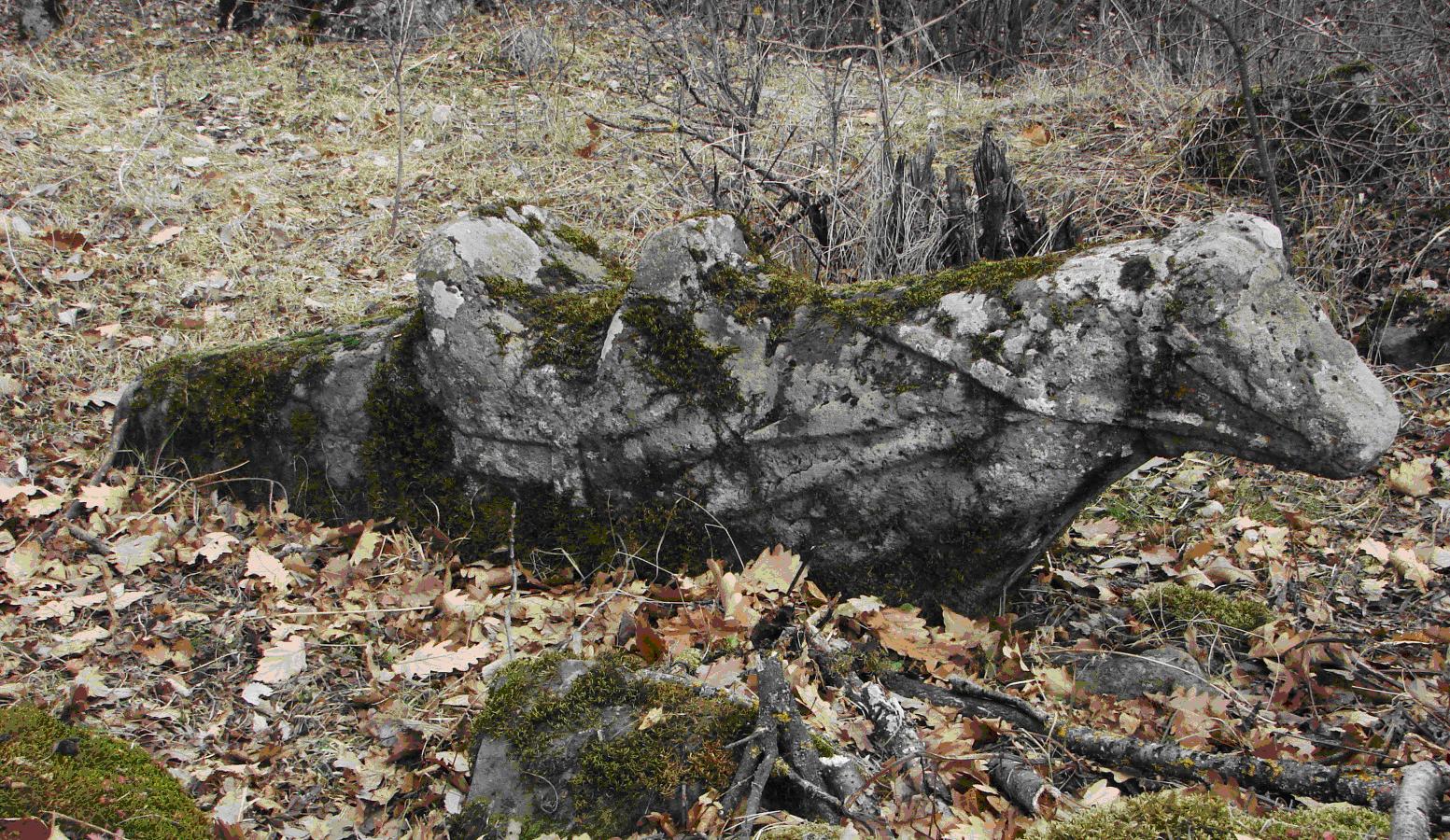
*
Prof. Robert Bleichsteiner had this to say concerning the first horse-shaped stele:
Schließlich müssen in deisem Zusammenhang noch die tiergestaltigen Grabsteine erwähnt werden, die sich an verschiedenen Orten—Samsschwilde, Khsowrethi, Wake, Did-Daghethi, Taschbasch und Ssomchethi—des georgischen Rayons Aghbulach-C'alka finden. Es sind Steinstatuen von Schafen, ... und Pferden, deren Verbreitungsgebiet aber weit über Georgien hinausgeht. Auf die pferdegestaltigen Grabsteine des Aghbulacher Rayons haben schon M. BROSSET, S. MASHNIKOW und neuerdings G. TSCHITAIA hingewiesen. [S. MASHNIKOW, Pamjatniki drewnosti goroda Samšwilde, Sborn. Mat. XIII (1892), S. 8; G. TSCHITAJA, P'it'aret'isa da Gudarehis sap'lawis-k'webi. Sak'art'wel. Mus. Moambe III (1927), S. 109-126.] Fig. 5 zeigt nach der Abbildung bei MASCHNIKOW die Roßstatue des Friedhofes an der Kirche Mariä Himmelfahrt in der Ruinenstadt Ssamschwilde, einem der ältesten Orte der Provinz Kharthli. Das Tier ist vollständig aufgeschirrt mit Zaum, Steigbügel, Sattel und Schwanzriemen; nur die äußeren Umrisse des Pferdes sind herausgemeißelt, den Raum zwischen den nicht ausgearbeiteten Beinen nimmt eine behauene Steinfläche ein, auf der die Gestalt des Verstorbenen mit auf der Brust gekreuzten Armen dargestellt ist. Links und rechts von der Figur sind Weingefäß, Wasserkrug, Trinkhorn, Messer, Gewehr und Patronenbehälter, Dolch, Stab und Äxte (?) abgebildet. Darstellungen solcher Art finden sich auch auf rechteckigen Grabsteinen der erwähnten Provinz, wie auch auf alten armenischen Friedhöfen. Die Entstehung dieser Grabdenkmäler fällt nach TSCHITAIA in die Zeit zwischen der Einführung der Feuerwaffen und der endgültigen Verwüstung des Aghbulagher Bezirkes durch die Perser, also vom 15. bis zum 18. Jahrhundert. Die Verzendung des Pferdes als Grabstein hat den Zweck, dem Toten sein Reittier wenigstens im Bilde zur Verfügung zu stellen; demselben Gedankengang dienen die auf der Vorderseite abgebildeten Waffen, Geräte und Gefäße.
BLEICHSTEINER, Robert, "Roßweihe und Pferderennen im Totenkult der kaukasischen Völker", in KOPPERS (ed.), Die Indogermanen- und Germanenfrage: Neue Wege zu ihrer Lösung, Salzburg: Verlag Anton Pustet, 1936, pp. 484-485.
*
Samshvilde is barely an hour's drive from Tbilisi, and lies not far from the small town of Tetritskaro. (Any potential visitors will need a sturdy four wheel drive vehicle.) The site is best visited in Spring, before the vegetation has had the chance to cover up the ruins (most particularly the low-lying horses), and before the region's notorious poisonous snakes emerge in the shimmering summer heat... The modern village of Samshvilde (populated by Armenians) lies on the near side of the Khrami river gorge, which forms the northern flank of the hilltop site.
I stumbled upon these two ram-shaped tombstones—held among the collections of the archaeological museum in Diyarbakir—on page 413 of the superb exhibition catalogue entitled Turks: A Journey of a Thousand Years, 600-1600 (Royal Academy of Arts, London: 2005—Buy it! BUY IT NOW!! It is amazing!)
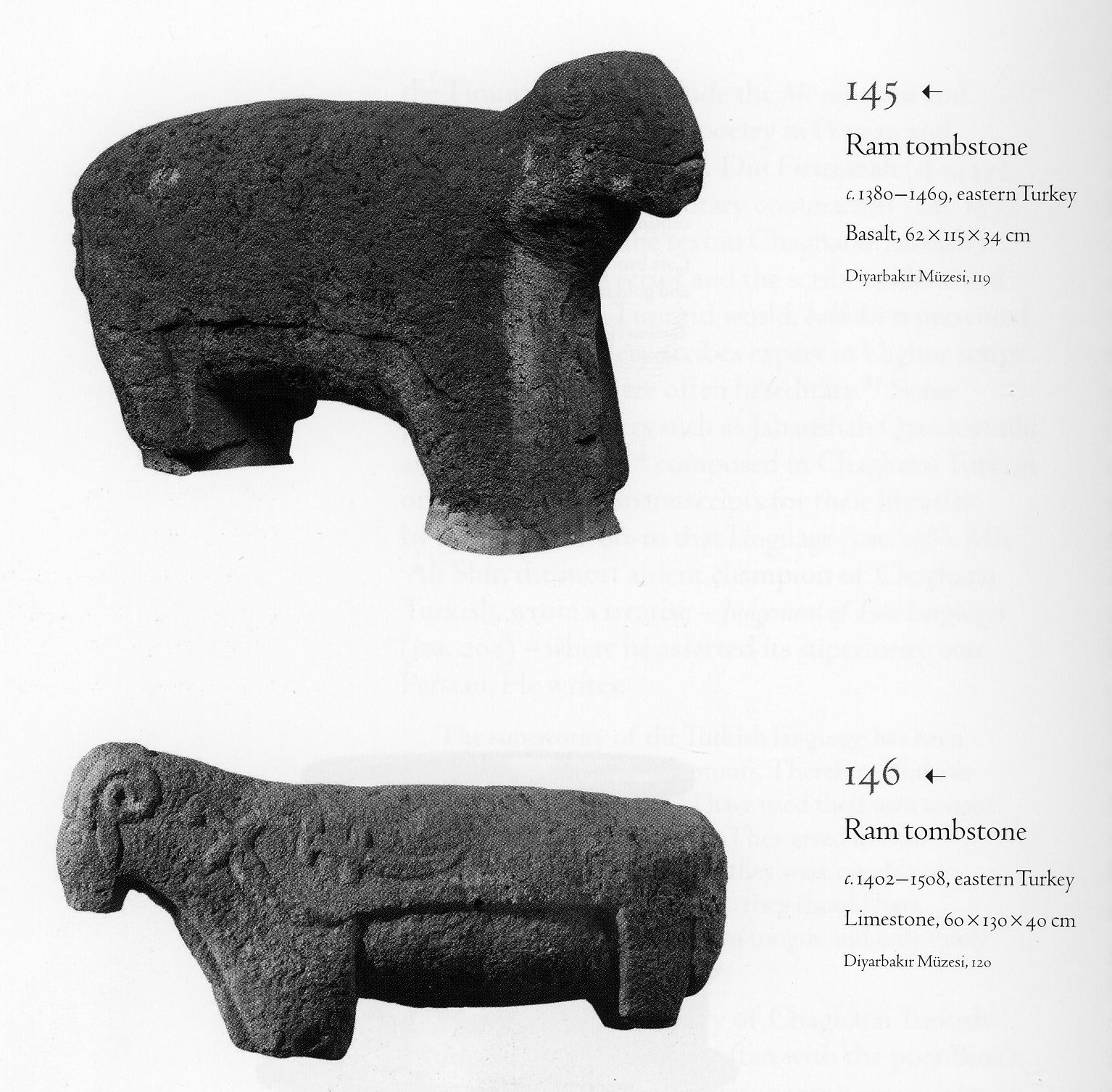
The entry reads:
145 & 146, two ram-shaped tombstones, the first dating from c.1380-1469, provenance: eastern Turkey, made of basalt, measuring 62x115x34 cm., the second dating from c.1402-1508, provenance: eastern Turkey, made of limestone, measuring 60x130x40 cm., both held in the Diyarbakır Müzesi.
[...]
Carved gravestones in the form of rams, sheep and horses were common in Anatolia, especially in the eastern and southern regions. They are known from the examples still in situ at burial sites in the vicinities of Tunceli, Akşehir, Afyon, Seyhitgazi and Ahlat, as well as from examples now housed in local museums, including those at Diyarbakır, Elazığ, Erzurum, Kars and Van. Such grave markers are also known from sites in Georgia and Azerbaijan, indicating the extent of their use, and appeared not only on Muslim graves but also on those of Armenian and Georgian Christians (Karamağaralı 1992, p.35). The Christian examples are identifiable as such by the presence of crosses and inscriptions. Of all the extant Muslim examples, none appears to have been made for a deceased woman or religious leader.
Rams and sheep are the most commonly used types. The carved form of the ram or sheep are rendered in a robust manner with detail supplied sparingly to fashion the spiralling lines of the horns. Some examples have additional relief carvings on their surfaces, usually showing weapons, a rider on his mount, horses or deer. Cat.146, for example, features a dagger on one side and a sword on the other. Though lacking inscriptions, cats. 145 and 146 are dated on the basis of stylistic similarity to examples bearing dates from the early 1400s, located in situ at Ahlat, south-eastern Turkey [on the western shores of Lake Van]. They are attributed to members of the Qaraqoyunlu ('Black Sheep') and Aq-Qoyunlu ('White Sheep') Turkmen confederations because rams and sheep were central to the economic currency of these pastoralist nomadic groups, and sculptures of them were probably symbols of social status. Relief carvings of weapons or imagery suggestive of hunting presumably referred to those skills of the deceased that were valued among pastoralist groups.
Efforts have been made to link the practice of using ram and sheep grave markers to the milieu of Central Asia and points further east, as parts of the shamanistic burial rites of various Turkic groups and Mongols in earlier times (as far back as the seventh century, but continuing until the thirteenth century). Such arguments combine the evidence of excavated tomb sites, where wooden carved effigies of sheep were placed alongside the deceased, with verbal descriptions of burial customs by European travellers to the region—for example, Giovani de Piano del Carpini (d.1252) and Wilhem von Ruysbroeck (c.1210-70), whoe undertook missions to the Mongol court in 1245-47 and 1253-55 respectively (Karamağaralı 1992, pp.37-9). Most of these burial rites, however, focus on the horse, and their relevance to Muslim burial customs is questionable.
There are near-identical horse- and sheep- (or ram-?) shaped tombstones near the monastery of Teghenyats in Armenia (see image below), as well as in Dmanisi in southern Georgia.
For more information on the symbolism and role of horses in funerals among the Khevsur mountaineers of northern Georgia, please see this page.
Unless stated otherwise or obviously not the case, all the text and images on this website are © A.J.T. Bainbridge 2006-2011
Do get in touch! Gmail: alexjtb

